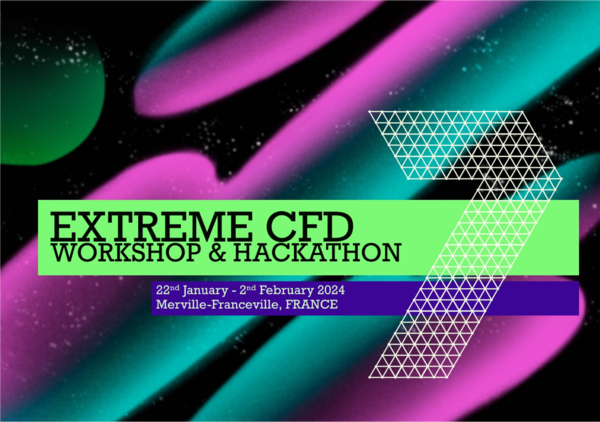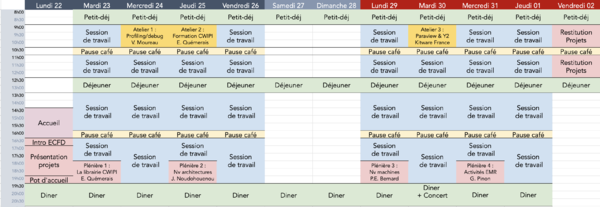Difference between revisions of "Ecfd:ecfd 7th edition"
m (→N6: Electrodeformation of red blood cells, extension to 3D and improved accuracy at membrane - A. Spadotto & S. Mendez (IMAG), M. Bernard (LEGI)) |
(→Hackathon - P. Begou, LEGI) |
||
| Line 45: | Line 45: | ||
== Projects == | == Projects == | ||
| − | === Hackathon - P. Begou, LEGI === | + | === Hackathon GENCI - P. Begou, LEGI === |
| + | The GENCI Hackathon will be devoted to porting two CFD codes to the Mi250 GPUs of the Adastra supercomputer deployed by GENCI at CINES. | ||
| + | For the '''YALES2''' code the goal is to obtain a first reference version giving the expected results then, if possible, to start its optimization to gain performance. The approach is OpenACC based with the objective of an implementation as least intrusive as possible in the existing code and which remains portable with the work done on the Nvidia GPUs of the Jean-Zay supercomputer at IDRIS. | ||
| + | |||
| + | The porting of the '''AVBP''' code is more advanced with a prototype already functional on Adastra but "hard-coded". The objective is to rationalize this first implementation, to integrate the latest developments in the code, to centralize memory management (host and device), to work on porting the Lagrangian part of the code and, of course, to improve the global performance. | ||
| + | |||
| + | This Hackathon is supported by GENCI, HPE, AMD and CINES with the presence on site of several development experts on AMD GPUS. | ||
=== Mesh adaptation - R. Letournel, Safran === | === Mesh adaptation - R. Letournel, Safran === | ||
Revision as of 09:56, 5 February 2024
Contents
- 1 Description
- 2 Agenda
- 3 Thematics / Mini-workshops
- 4 Projects
- 4.1 Hackathon GENCI - P. Begou, LEGI
- 4.2 Mesh adaptation - R. Letournel, Safran
- 4.3 Numerics - S. Mendez, IMAG & G. Balarac, LEGI
- 4.3.1 WIP N1: High-Order schemes for Navier-Stokes - M. Bernard & G. Balarac (LEGI) & G. Lartigue (Total Eneriges)
- 4.3.2 N5: Optimization of the RBC solver - F. Rojas & S. Mendez (IMAG)
- 4.3.3 N6: Electrodeformation of red blood cells, extension to 3D and improved accuracy at membrane - A. Spadotto & S. Mendez (IMAG), M. Bernard (LEGI)
- 4.4 Turbulence - P. Benard, CORIA & L. Bricteux, UMONS
- 4.5 T4: Atmospheric solver
- 4.6 Two Phase Flow - M. Cailler, Safran Tech & V. Moureau, CORIA
- 4.7 Combustion - K. Bioche, CORIA & R. Mercier, Safran
- 4.8 User Experience & Data - L. Korzeczek, GDTech
Description
- Event from 22th of January to 2nd of February 2024
- Location: Hôtel Club de la Plage, Merville-Franceville, near Caen (14)
- Two types of sessions:
- common technical presentations: roadmaps, specific points
- mini-workshops. Potential workshops are listed below
- Free of charge
- More than 70 participants from academics, HPC center/experts and industry.
- Objectives
- Bring together experts in high-performance computing, applied mathematics and multi-physics CFDs
- Identify the technological barriers of exaflopic CFD via numerical experiments
- Identify industrial needs and challenges in high-performance computing
- Propose action plans to add to the development roadmaps of the CFD codes
Agenda
Thematics / Mini-workshops
These mini-workshops may change and cover more or less topics. This page will be adapted according to your feedback.
To come...
Projects
Hackathon GENCI - P. Begou, LEGI
The GENCI Hackathon will be devoted to porting two CFD codes to the Mi250 GPUs of the Adastra supercomputer deployed by GENCI at CINES.
For the YALES2 code the goal is to obtain a first reference version giving the expected results then, if possible, to start its optimization to gain performance. The approach is OpenACC based with the objective of an implementation as least intrusive as possible in the existing code and which remains portable with the work done on the Nvidia GPUs of the Jean-Zay supercomputer at IDRIS.
The porting of the AVBP code is more advanced with a prototype already functional on Adastra but "hard-coded". The objective is to rationalize this first implementation, to integrate the latest developments in the code, to centralize memory management (host and device), to work on porting the Lagrangian part of the code and, of course, to improve the global performance.
This Hackathon is supported by GENCI, HPE, AMD and CINES with the presence on site of several development experts on AMD GPUS.
Mesh adaptation - R. Letournel, Safran
Numerics - S. Mendez, IMAG & G. Balarac, LEGI
Finite Volumes method. Distinction between integrate and pointwise quantities. Spacial accuracy depend on ability to evaluate accurately fluxes, starting from integrated quantities. Accurate evaluation of fluxes through interface of each control volume (CV). OK inside the domain, but chalenging in case of boundary conditions : by definition non uniformity of the stencil. BC on faces instead of nodes. Enforcement of the BC by modifying the normal component of the wall gradient in order to evaluate accurate diffusif flux. Treatment of inlet BC by integrating convective flux through each boundary-facelet.
N5: Optimization of the RBC solver - F. Rojas & S. Mendez (IMAG)
N6: Electrodeformation of red blood cells, extension to 3D and improved accuracy at membrane - A. Spadotto & S. Mendez (IMAG), M. Bernard (LEGI)
The Leaky Dielectric Model is a popular framework to describe electric stresses over micro-scale membranes. We have adopted it to simulate the effect of a DC electric field on a red blood cell using the YALES2BIO solver. The goal of the project is to reproduce the electric charging process of the membrane, as well as the resulting stresses, which may yield to electrodeformation of the cell. From the point of view of the implementation, the grid is represented by a 2D surface mesh embedded in a 3D eulerian grid. The need to make variables stored on the surface interact with quantities stored on the Eulerian grid calls for a proper bidirectional 2D-membrane/3D-grid dynamic connectivity. The advancement of theis task during this ECFD has led to the first 3D simulation of a charging fixed spherical shell. Moreover, the estimation of grid variables on elements cut by the membrane has been improved thanks to a High-Order extrapolation. The latter has been successfully tested on 2D configurations. The project opens the way for a series of validation tests. In particular, future work will demand treatment of instabilities emerging in symmetrical configurations.
Turbulence - P. Benard, CORIA & L. Bricteux, UMONS
T4: Atmospheric solver
Wind turbines, bigger and bigger, are now influenced by atmospheric flows. An atmospheric solver has already been developed in YALES2 to represents some of its effects (Coriolis, veer, thermal stratification). In this continuum, the project has been divided into two work-packages. - Work-package 1: The use of the Variable density solver (VDS). Before ECFD7, thermal stratification was taken into account using the Boussinesq buoyancy approximation within the incompressible solver framework. Now, VDS can be used, taking into account all thermal effect. Results are promissing. - Work-package 2: Wall law velocity filtering. Wall law are using velocity at the first grid node to compute wall shear stress. Before ECFD7, atmospheric wall law were using the local velocity, leading sometimes to convergence errors. Now a gather-scatter filter can be used to average velocity (and temperature) at first grid node.


